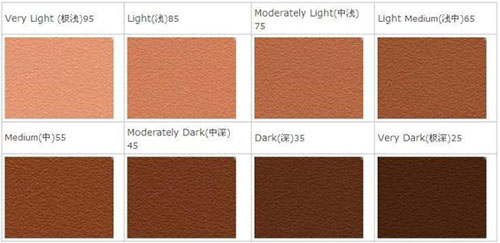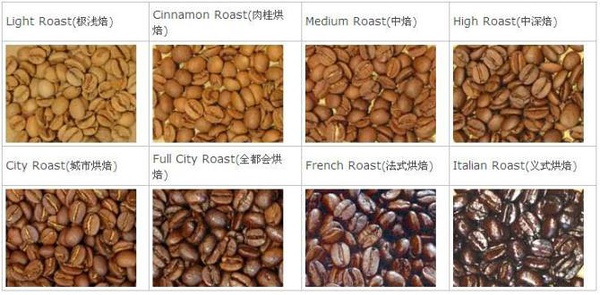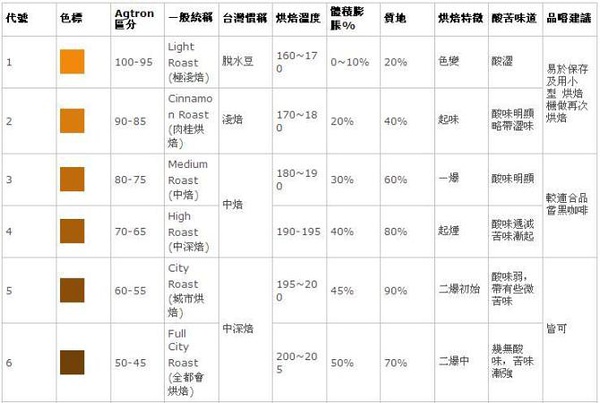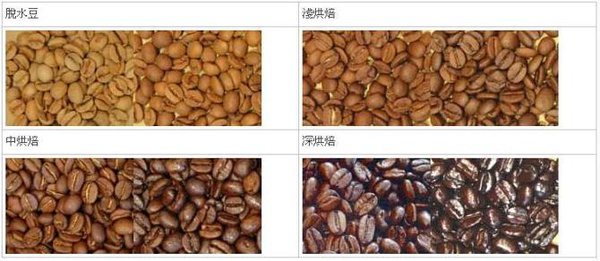Coffee roasting basic knowledge Coffee roasting degree Resolution Chart
American Coffee Association (SCAA) roasting standard this standard uses infrared caramelization tester technology (Agtron) to measure the color of coffee beans to determine the roasting degree of coffee, and the color is divided into eight equal parts into eight standard color blocks for coffee industry as roasting identification.

The above colors are only for reference according to the roasting degree preferred by each country, which is also the earliest distinction of coffee roasting degree. Because different countries and regions have different taste preferences for coffee roasting degree, it is known as roasting degree by country or region, such as Italian roasting, French roasting and so on. However, the baking degree of these different preferences are integrated and arranged from shallow to deep to form the distinction index of baking degree, but because the standard is too general, different bakers have different identification of baking degree.

The above colors are only for reference to the distinction between the usual baking degrees in Taiwan in recent years, most of them lock in the changes in the sound of baking to determine the degree of baking.


Time point of beans under the degree of baking
Shallow baking (light) burst density
Medium Bakery / City (medium/city) first explosion and second explosion room
The second explosion of full city begins.
After the second explosion of Italian / Italian/French

Roasting of coffee
Through the burning of the fire, release the aroma of coffee, and sprinkle the sour, sweet and bitter taste of ─ contained in each bean incisively and vividly, from insipid raw beans to the endless aftertaste of mellow ─ roasting in the cup, which is the most important stop to outline the character and nurture fragrance in the long journey of every coffee bean.
Whether in a professional roaster, on your own fire or in the oven, coffee beans have to go through many chemical changes during this 12-16-minute conversation with a hot cut at a temperature of up to 450C, making a second popcorn-like crisp sound and losing 15% ─ 25% of water.
Baking process, like popcorn full of fragrance and joyful bouncing sound. From raw beans, light roasting to deep roasting, the water is released again and again, the weight is reduced, but the volume slowly expands and bulges, the color of coffee beans deepens, the fragrant oil is gradually released, and the texture becomes crisp. Raw beans ─ each coffee cherry contains two raw beans, and the fragrance is still deep in it, waiting to be discovered. Raw beans contain a lot of chloric acid, which disappears with the baking process, releasing familiar and pleasant fruit acids such as acetic acid, citric acid, and malic acid found in wine. Baking is just right to present these beautiful sour tastes in moderation, while if you bake them too much, they will be completely masked. When baked for 5-7 minutes, the beans begin to release water, changing from light green to orange, emitting the unique aroma of creamy roasted vegetables.
Light baked ─ when the beans make the first light sound, the volume expands at the same time, and the color changes to a delicious cinnamon color, so it is also called cinnamon raost or half-city roast. Acidity dominates the flavor of shallow roasted beans, texture and taste have not been brought into full play, so they are generally used as canned coffee, can not meet the real coffee experts.
When roasted in medium ─ for 10-11 minutes, the coffee beans are elegantly brown. New Yorkers like to start each day by roasting coffee beans with fragrant milk and sugar at breakfast, so this method of baking is also called breakfast roast or city roast. Medium roasting can not only preserve the original flavor of coffee beans, but also moderately release aroma, so Blue Mountains, Colombia, Brazil. Wait for a single cup of coffee, choose this kind of baking method. At 12-16 minutes, the oil begins to surface, and the beans are burned to a bright dark brown, called full-city roast. Some people think that the sour, sweet and bitter taste of coffee reaches the perfect balance, and the character of coffee beans is clearly carved out.
The darker the color of deep-roasted ─ coffee beans, the sweeter the flavor, when the oil has been turned into caramel, bitter, endless aftertaste, the most suitable for brewing strong Espresso coffee, so it is also called Italian roasting. Moderate roasting gives life to the coffee beans and turns into an intriguing sour, sweet, bitter and astringent taste. However, people who are sensitive to caffeine might as well choose deep-roasted beans as much as possible, because caffeine will slowly escape during baking, so the deeper the roasted beans, the lower the caffeine content.
Note: the sour and bitter taste of roasting degree will still vary from coffee to coffee. Tasting advice is only a personal opinion, and the main way to drink varies from person to person.
Important Notice :
前街咖啡 FrontStreet Coffee has moved to new addredd:
FrontStreet Coffee Address: 315,Donghua East Road,GuangZhou
Tel:020 38364473
- Prev

Coffee common sense roasting and mixing of coffee beans
When high-quality coffee beans are picked, the most important step in making them gourmet coffee is roasting and mixing. A master baker must have both the temperament of an artist and the rigor of a scientist. Only in this way can we ensure that the sugars and other carbohydrates contained in the coffee are carbonized during the roasting process, thus producing the well-known coffee fat and producing good coffee with high quality and consistent style.
- Next

The main varieties and characteristics of coffee beans
Blue Mountain Coffee: Produced in Jamaica, it is mellow, slightly sour, supple, sweet, delicate in flavor and light in taste. Colombia: Produced in South America, slightly sour, mellow, soft and mellow, slightly sour to medium acid. Brazil: produced in South America, neutral, medium bitter, fragrant, slightly sour, slightly bitter, restrained. Mantenin: produced in Indonesia ~ Sumatra, bitter, fragrant bitter. Mocha: Produce esopi
Related
- Beginners will see the "Coffee pull flower" guide!
- What is the difference between ice blog purified milk and ordinary milk coffee?
- Why is the Philippines the largest producer of crops in Liberia?
- For coffee extraction, should the fine powder be retained?
- How does extracted espresso fill pressed powder? How much strength does it take to press the powder?
- How to make jasmine cold extract coffee? Is the jasmine + latte good?
- Will this little toy really make the coffee taste better? How does Lily Drip affect coffee extraction?
- Will the action of slapping the filter cup also affect coffee extraction?
- What's the difference between powder-to-water ratio and powder-to-liquid ratio?
- What is the Ethiopian local species? What does it have to do with Heirloom native species?

